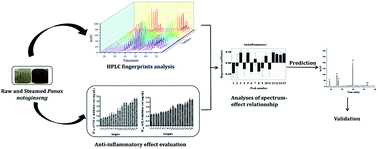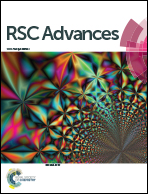Identification of anti-inflammatory components of raw and steamed Panax notoginseng root by analyses of spectrum-effect relationship†
Abstract
To identify bioactive components of Panax notoginseng (PN) roots in raw and steamed forms, chemometrics analyses including bivariate correlation analysis and partial least squares regression were used to establish the relationships between the chromatograms and anti-inflammatory effect of PN samples. The chemical fingerprints of PN were obtained by high performance liquid chromatography. The anti-inflammatory activity was evaluated by the TNF-α and IL-6 inhibiting test. According to the results, raw PN (RPN) displayed a stronger anti-inflammatory effect compared with steamed PN (SPN) samples. Chemometrics analyses showed that notoginsenoside R1, ginsenosides Rg1, Re and Rb1 were the major anti-inflammatory components of RPN, whereas ginsenosides 20(S)-Rg3 was the active one of SPN treating inflammation. The pharmacologic verification was consistent with the predicted results. In addition, the contents of anti-inflammatory components in RPN were higher than those in SPN, which might be the reason that RPN exhibited stronger effect on the inflammation induced by lipopolysaccharide in RAW264.7 cells. These findings could be beneficial for choosing differential markers for the quality control of RPN and SPN.



 Please wait while we load your content...
Please wait while we load your content...